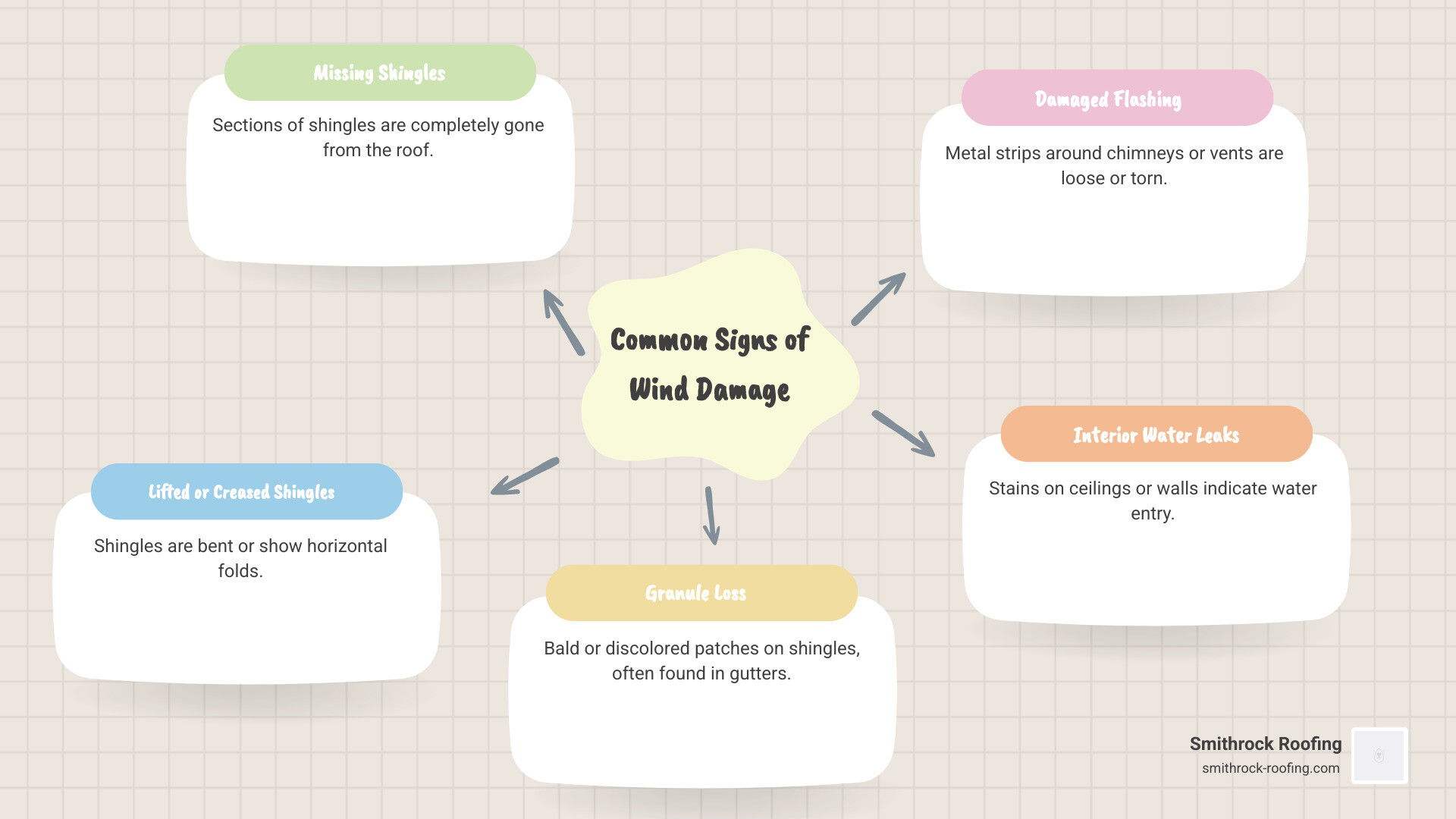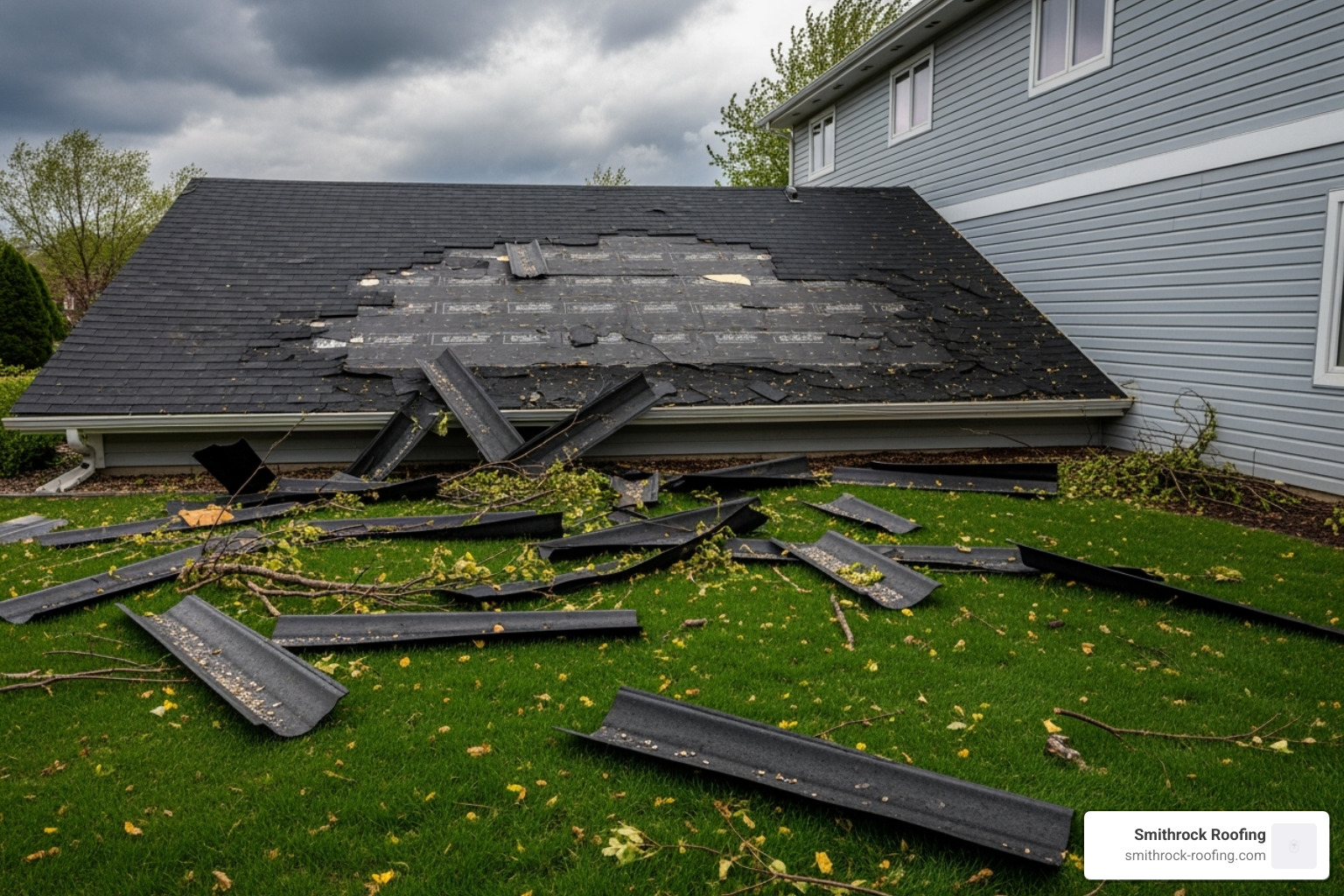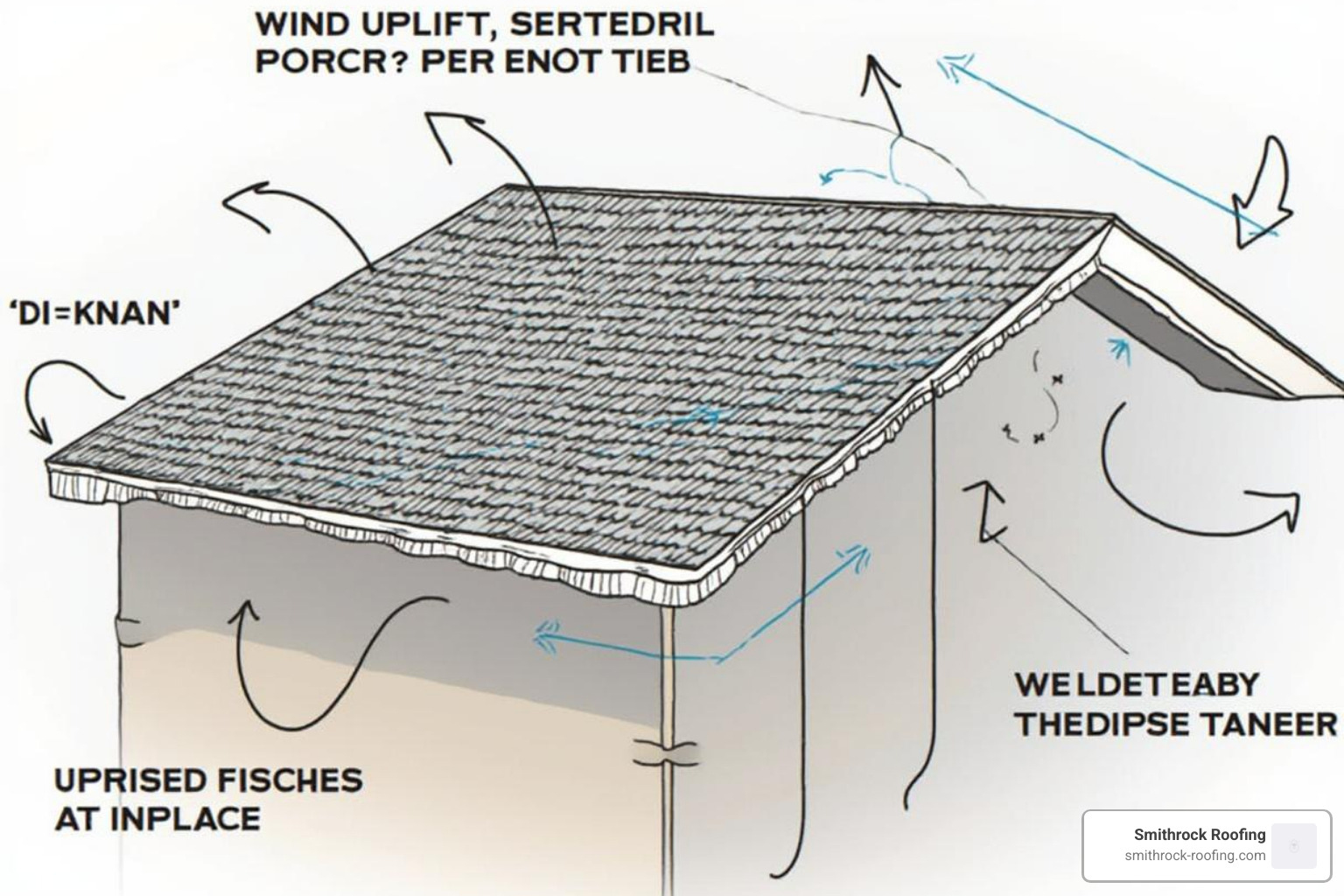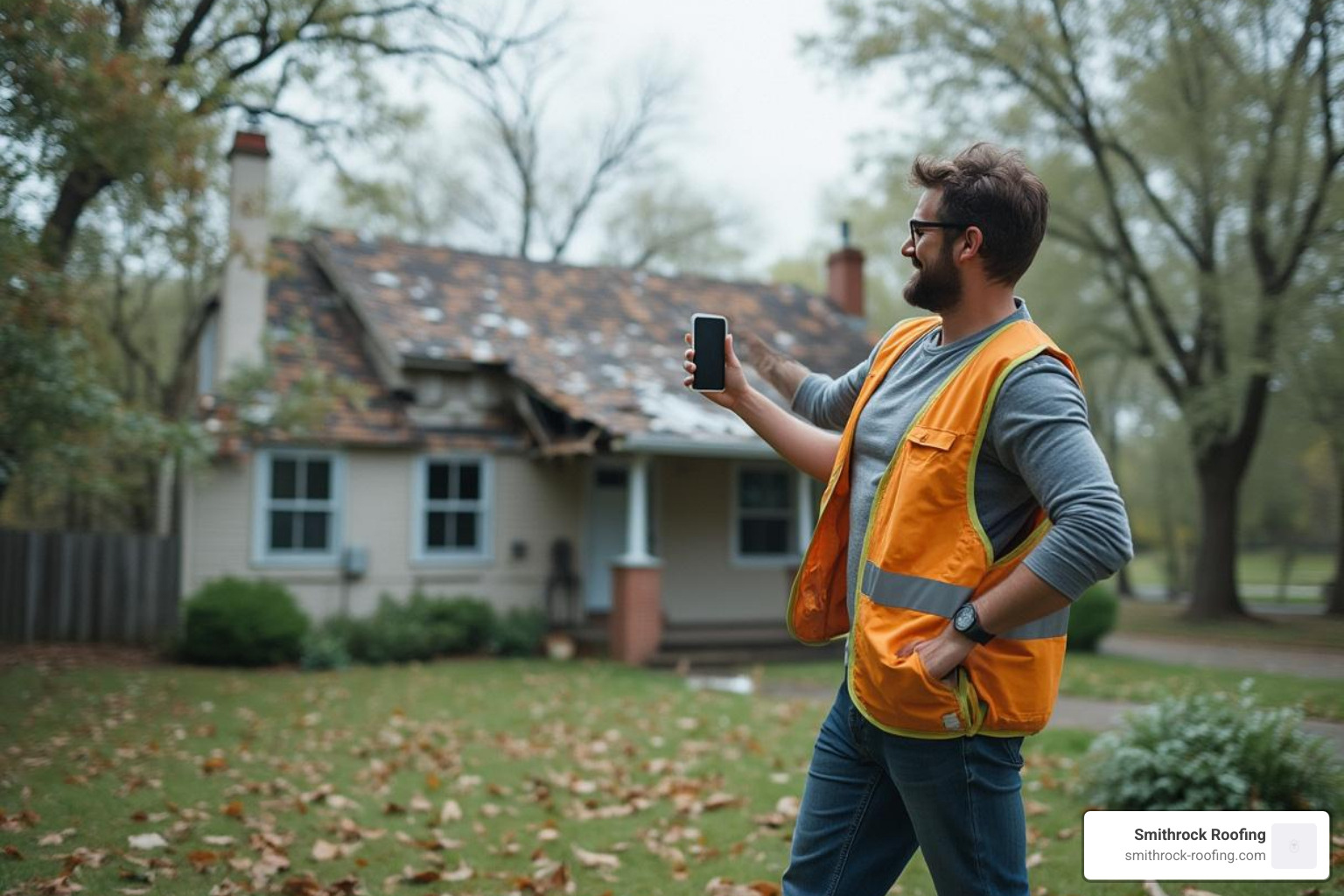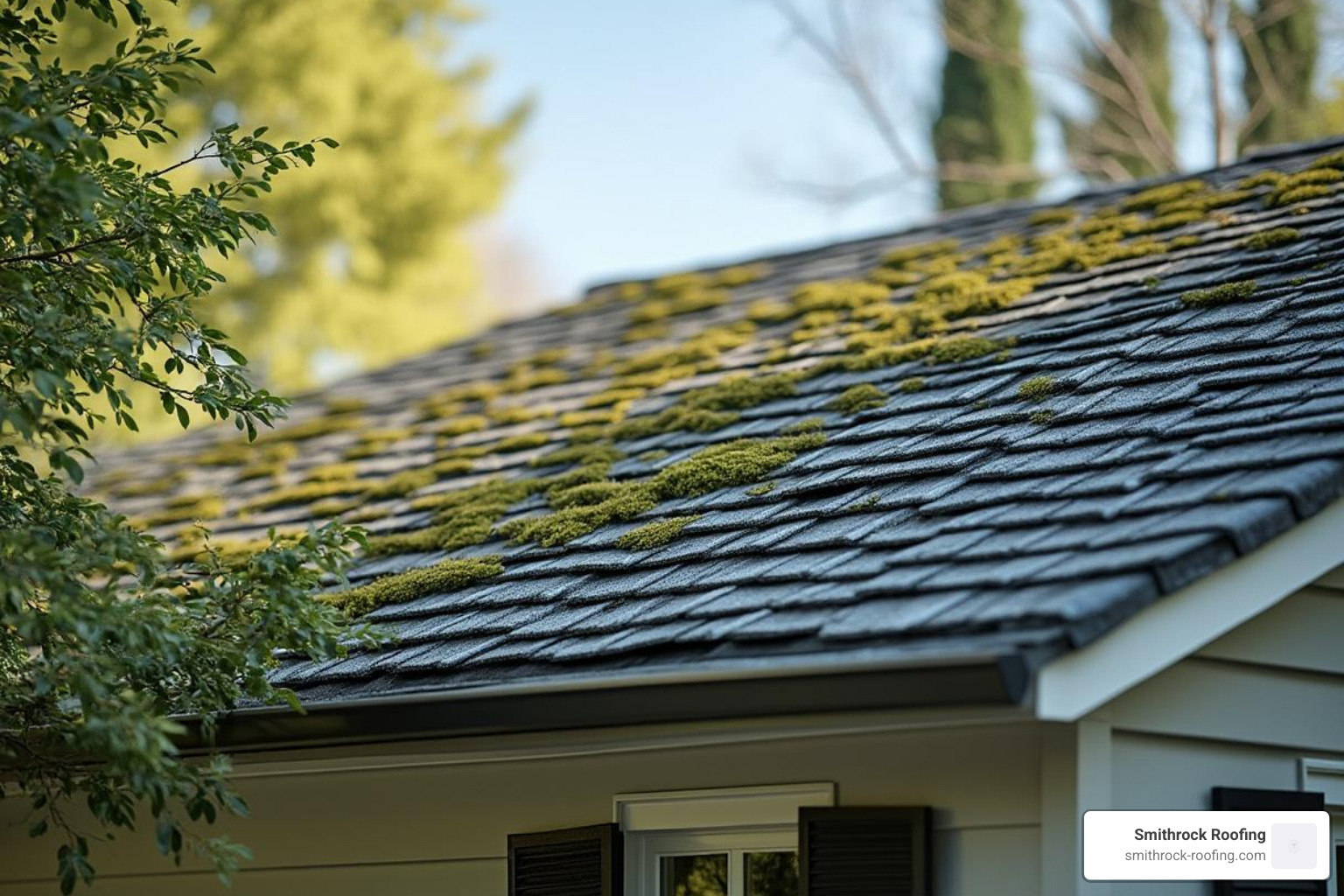Wind damage to roof: Secure Home 2025
Why Wind Damage to Your Roof is a Concern
Experiencing wind damage to roof can be a homeowner’s nightmare. High winds, whether from a thunderstorm or hurricane, can compromise your home’s most vital shield. This damage isn’t always obvious from the ground, but it can lead to bigger problems like leaks, structural issues, and costly repairs if ignored.
Here are the common signs of wind damage to a roof:
- Missing Shingles: Sections of shingles are completely gone.
- Lifted or Creased Shingles: Shingles are bent or have horizontal folds, indicating they’ve been pulled up by wind.
- Granule Loss: Bald or discolored patches on shingles, often found in gutters.
- Damaged Flashing: Metal strips around chimneys or vents are loose or torn.
- Interior Water Leaks: Stains on ceilings or walls.
- Damaged Gutters or Soffits: Gutters are bent, detached, or filled with shingle granules.
I’m Jordan Smith, and with over 15 years in exterior construction and 40+ years combined experience at Smithrock Roofing, I’ve seen the devastating impact of wind damage to roof. My team and I founded Smithrock Roofing in 2016 to bring honesty, integrity, and affordable solutions to homeowners facing these challenges.

Wind damage to roof vocab explained:
Identifying the Telltale Signs of Wind Damage
The wind is a mighty force, and when it sets its sights on your roof, the damage can range from obvious to hidden. Unlike hail damage, which often requires a trained eye, wind damage to roof can sometimes be easier to spot. However, some signs are subtle and require a professional inspection. Learning to recognize these clues is the first step in protecting your home from bigger headaches down the road.
Exterior Signs You Can Spot from the Ground
After a storm, take a careful walk around your home, but always check for downed power lines or other hazards first. From the ground, here’s what to look for:
- Missing Shingles: Finding shingles or pieces of them in your yard is the most undeniable sign of wind damage to roof. Look for specific patterns of loss; damage often starts at the corners, eaves, and the roof ridge, where wind forces are strongest. Once one shingle is gone, it can create a “zipper effect,” making adjacent shingles much more vulnerable to being torn off. Finding entire shingles in yard is a clear indicator that your roof’s outer layer has been breached and is exposed to the elements.
- Curling, Lifted, or Creased Shingles: Wind doesn’t have to rip a shingle off completely to cause damage. It can lift shingles and break the crucial sealant strip that bonds them together. This results in edges that curl upwards or entire shingles that appear lifted. Look for horizontal creases or folds, which are stress marks showing the shingle was bent back by the wind. Even if the shingle lies flat again, the broken seal means it’s no longer watertight, creating a prime spot for water to sneak underneath and rot the roof deck.
- Damaged Gutters and Soffits: High winds can bend, dent, or tear your gutter system away from the house. An unusual amount of gritty, sand-like material in your gutters is a major red flag for granule loss from your shingles. These granules are not just for color; they are the shingle’s primary defense against UV radiation and fire. Their loss exposes the underlying asphalt to the sun, causing it to become brittle and crack, drastically shortening your roof’s lifespan. Also, check for soffit and fascia damage, as wind can tear these boards loose, creating gaps for water and pests to enter your attic.
- Debris on Roof: Large branches or other debris on roof after a storm indicates strong winds were at play. This debris can cause direct impact damage, puncturing shingles and the decking below, or it can rub against the roof surface, scraping away protective granules.
- Damaged Flashing Around Chimney or Vents: Flashing is the metal stripping that seals joints around chimneys, vents, and skylights. It’s a common failure point. Strong winds can lift, bend, or tear this damaged flashing, breaking the waterproof seal and creating a direct path for rainwater into your home.

Interior Clues and Damage Requiring a Closer Look
Sometimes the earliest signs of wind damage to roof appear inside your home, usually pointing to water intrusion that can lead to mold, rot, and structural issues if not addressed.
- Water Stains on Ceiling: This is a classic signal of a roof leak. Look for discolored brown, yellow, or gray patches on your ceilings or running down your walls. Even a small stain can indicate a much larger, saturated area in the attic above.
- Damp Spots in Attic: After a storm, use a flashlight to inspect your attic for damp spots on insulation, wooden beams, or the underside of the roof decking. Saturated insulation loses its R-value and becomes a breeding ground for mold and mildew. A musty, earthy smell is also a giveaway of hidden moisture.
- Daylight Visible Through Roof Boards: If you can see sunlight through cracks in your attic, your roof’s shield has been broken. This is an emergency situation, as any amount of rain will pour directly into your home, requiring immediate attention.
- Sagging Roof Deck: A sagging roof deck in the attic, which may look like a dip or bow between the rafters, suggests the underlying structure (the OSB or plywood sheathing) is weakened. This is often caused by long-term water damage that has led to wood rot, compromising the structural integrity of your entire roof system.
- Spongy Feel When Walking on Roof: Warning: Do not walk on your roof unless you are a trained professional with proper safety gear. A professional roofer might notice a spongy feel underfoot, which is a serious sign of water saturation and rot in the roof decking.
- Lifted Sealant Strips: Strong winds can break the asphalt seals that hold shingles down without tearing the shingle off. A professional inspection can reveal these broken seals, which are invisible from the ground but leave your roof highly vulnerable in the next storm.
- Exposed Nails: Wind uplift can cause shingles to shift and pull on the fasteners, causing nails to pop up. These exposed nails back out through the shingle, creating tiny holes that act like funnels for water to enter the roof system.
If you spot any of these signs, it’s important to act quickly. Even small hints of wind damage to roof can quickly turn into major issues.
The Science of Wind: What Causes Roof Damage?
Understanding how wind impacts your roof is key to assessing damage and preventing future issues. It’s not just about wind pushing down; it’s a complex interaction of forces. Wind flowing over your roof creates positive pressure on the windward side and a powerful suction, or negative pressure (uplift), on the leeward side and top. This “wind loading” is strongest at the edges, corners, and ridge, causing shingles to lift and tear away, much like peeling a sticker. This uplift force is often far more damaging than direct pressure.

Types of Damaging Winds
Certain wind events are notorious for causing severe wind damage to roof:
- Thunderstorm Winds: These are a leading cause of property loss. Winds of 40-45 mph can snap small branches, and speeds of 55-65+ mph can begin to peel off older or improperly installed shingles and cause structural damage.
- Straight-Line Winds: These powerful, non-rotating thunderstorm winds can exceed 100 mph. A Derecho is a particularly intense, long-lived storm system that produces widespread and destructive wind damage across a vast area.
- Tornadoes: These are localized but extremely intense, with wind speeds that can reach up to 300 mph. The combination of extreme uplift and flying debris is capable of devastating even the most well-built structures.
- Hurricanes: These massive storm systems bring sustained high winds (over 74 mph) over a vast area, causing widespread and catastrophic damage. The prolonged duration of hurricane-force winds puts immense, repeated stress on a roof system.
It doesn’t take a hurricane to cause significant wind damage to roof. Winds over 50 mph can cause minor damage, and most standard roofs are designed to withstand speeds up to 110 mph, but this capability is highly dependent on other factors. You can learn more about these forces from damaging winds explained by NOAA.
Key Factors Influencing Roof Vulnerability
Why does one roof suffer damage while its neighbor doesn’t? The answer usually involves several crucial factors:
- Roof Age and Condition: An older or poorly maintained roof is far more vulnerable. Over time, asphalt shingles undergo a process called volatilization, where essential oils that keep them flexible dry out. This makes the shingles hard, brittle, and more likely to crack or tear in high winds. The sealant strips also lose their adhesive properties with age, weakening the bond between shingles.
- Roof Geometry (Hip vs. Gable): The shape of your roof plays a significant role. Gable roofs, with two sloping sides forming a triangular shape at the ends, present a large, flat surface to the wind, making them more vulnerable to uplift, especially at the rake edges. Hip roofs, which have four sloping sides, are more aerodynamic and generally more resistant to wind forces because they deflect wind more effectively.
- Quality of Installation: This is one of the most critical factors. Even the best materials can fail if not installed correctly. Common installation errors that lead to wind damage include high nailing (placing nails above the designated nailing strip), overdriven nails (using too much pressure and fracturing the shingle mat), or using too few nails. Improperly installed starter strips at the eaves and rakes can also lead to catastrophic failure at the roof’s edge.
- Roofing Material Type: Different materials offer varying wind resistance. Metal roofs and certain reinforced architectural shingles are generally more resistant than standard 3-tab asphalt shingles. The material’s design and weight contribute to its ability to stay put.
- Surrounding Landscape (Trees): Overhanging branches can act as levers in the wind, scraping away granules or breaking and falling on your roof, causing severe impact damage. Proactively trimming branches is an effective preventative measure.
- Building Codes: Modern building codes, especially in coastal or high-wind regions, often require specific construction techniques to improve wind resistance. These codes have evolved, largely in response to major storms like Hurricane Andrew. Older homes may be more susceptible because they were built to less demanding standards that didn’t emphasize things like a continuous load path from the roof to the foundation.
Your Post-Storm Action Plan: What to Do Immediately After Finding Wind Damage to Roof
Finding wind damage to roof is stressful, but a calm, organized response makes all the difference. Your safety and a methodical approach are paramount. Let’s walk through the essential steps.
Step 1: Prioritize Safety and Document Everything
Your first priority is ensuring your family’s safety. This comes before anything else.
- Assess from Ground: Do not get on your roof. It can be slippery and unstable. Walk around your home at ground level, using binoculars if possible, to look for missing shingles, debris, or damaged gutters.
- Check for Downed Power Lines: Be extremely cautious. If you see downed power lines, stay far away and contact your utility company immediately.
- Take Photos and Videos: This is critical for your insurance claim. From a safe vantage point, document all visible damage, including missing shingles, damaged gutters, fallen branches, and any interior leaks. Capture both wide shots and close-ups.
- Note Date and Time of Storm: Record the exact date and time the storm occurred to link the damage directly to the weather event.
- Keep Any Fallen Shingles or Debris: If safe, collect a few fallen shingles. They can serve as physical evidence for your insurance adjuster.

Step 2: Mitigate Further Damage
Once you’ve documented the damage, your next priority is to prevent further harm to your home.
- Place Buckets Under Interior Leaks: If you have active leaks, place buckets or towels under them to catch water and protect your flooring and belongings.
- Tarping the Roof (Professional Help Recommended): A temporary tarp can prevent more water from entering through holes or areas with missing shingles. We strongly recommend calling a professional for this task, as it requires expertise and safety equipment. Our team offers emergency roofer services to secure your home quickly.
- Removing Standing Water: If water has gotten inside, use a shop vac to remove it and set up fans to dry the area. This helps prevent secondary issues like mold and mildew.
After securing your home, get a professional assessment.
- Schedule a Professional Inspection: Contact a reputable local roofer like Smithrock Roofing. We can safely conduct a thorough inspection, identify all wind damage to roof, and provide a detailed report.
- Get a Detailed Damage Report: A trustworthy contractor will provide a comprehensive report with photos, outlining the damage, necessary repairs, and a cost estimate. This is invaluable for your insurance claim.
- Avoid Storm Chasers: Be wary of out-of-state companies that appear after a storm. These “storm chasers” often perform substandard work and disappear. Choose a local, reputable contractor with good reviews, proper licensing, and insurance.
When choosing a contractor, ask these questions:
- Are you licensed and insured in our state (North Carolina)?
- Do you have experience with wind damage to roof and insurance claims?
- Can you provide local references?
- What is your estimated timeline for repairs?
- Do you offer workmanship warranties?
- Will you assist with the insurance claim process?
Navigating the Insurance Maze for Wind Damage to Roof
Dealing with wind damage to roof is stressful, and navigating your homeowners insurance can add to it. Understanding your coverage and the claims process is key to a successful outcome and a fair settlement.
Understanding Your Homeowners Insurance Coverage
Most standard homeowners insurance policies include wind damage to roof as a “covered peril.” This means your policy should help cover the cost of repair or replacement. However, the details matter immensely.
Before calling your insurance company, review your policy documents. Look for sections on “wind damage” or “storm damage” and note your deductible—the amount you must pay out-of-pocket before your coverage begins. Be aware that some policies in high-risk areas may have a separate, higher wind deductible or hurricane deductible, which can be a percentage of your home’s insured value (e.g., 1-5%) rather than a flat dollar amount. Also, look for exclusions. Standard policies cover sudden, accidental events but will not cover damage resulting from neglect, lack of maintenance, or general wear and tear. If your roof was already in poor condition, your claim could be denied.
Wind and hail claims are very common, accounting for about 34% of all homeowners claims. Insurance companies are familiar with them, but it’s still crucial to be prepared. After documenting the damage and getting a roofer’s assessment, filing a claim promptly is vital. Most policies have a time limit for filing, sometimes as short as one year from the date of the storm. Delays can complicate the process or even lead to a denial.
It’s also important to understand your “duty to mitigate damages.” This is a policy condition that requires you to take reasonable steps to prevent further damage after a loss occurs, such as having the roof tarped. Failure to do so could result in the insurance company refusing to pay for any secondary damage (like interior water damage) that occurred after the initial storm.
Actual Cash Value (ACV) vs. Replacement Cost Value (RCV)
One of the most critical distinctions in your policy is whether you have an Actual Cash Value (ACV) or Replacement Cost Value (RCV) policy. This significantly impacts your payout.
An Actual Cash Value (ACV) policy pays the depreciated value of your roof. It subtracts for wear and tear based on the roof’s age and condition. For example, if your 15-year-old roof with a 30-year lifespan is destroyed, an ACV policy might only pay for half of the replacement cost. You will receive enough to cover the current value of your damaged roof, but not enough to fully replace it with new materials, leaving you to pay the difference.
A Replacement Cost Value (RCV) policy is far more favorable. It pays the cost to replace your damaged roof with new materials of similar kind and quality, without deducting for depreciation. Typically, the process involves two payments. You receive an initial payment (the ACV), and a second payment for the “recoverable depreciation” after the work is completed and you provide proof of payment to the contractor. This way, you get the full cost of a new roof, minus your deductible.
Here’s an example:
| Policy Type | Initial Payout (ACV) | Recoverable Depreciation (RCV) | Total Payout | Homeowner’s Out-of-Pocket (assuming $1,000 deductible) |
|---|
| ACV | $10,000 | N/A | $10,000 | $11,000 (for a $20,000 roof replacement) |
| RCV | $10,000 | $9,000 | $19,000 | $1,000 (for a $20,000 roof replacement) |
This table illustrates a hypothetical $20,000 roof replacement. With an RCV policy, the homeowner pays only their deductible.
Depreciation is the decrease in an item’s value over time. Under an RCV policy, this amount is initially withheld but can be recovered once repairs are done. Your out-of-pocket costs are your deductible plus depreciation (for ACV) or just your deductible (for RCV). Getting the full cost covered often requires supplementation, which is where an experienced roofer like Smithrock Roofing can help you steer the process. For more information on disaster recovery, you can check resources from FEMA.
Prevention and Mitigation: Fortifying Your Roof Against Future Winds
When it comes to wind damage to roof, an ounce of prevention is worth a pound of cure. While we can’t control the weather, we can control how well our roofs are prepared for it. Taking proactive steps can significantly reduce your roof’s vulnerability and give it a fighting chance against strong gusts, potentially saving you thousands in repairs and insurance deductibles.

Choosing Wind-Resistant Roofing Materials
If you’re considering a new roof, selecting materials known for wind resistance is a smart investment. Modern roofing technology offers excellent options.
- Metal Roofing: Widely regarded as one of the most windproof materials. Interlocking or overlapping panels, when properly fastened, create a secure, monolithic barrier that is extremely difficult for wind to get under and cause uplift.
- Impact-Resistant Shingles (Class 4): Modern architectural asphalt shingles have vastly improved wind resistance over older 3-tab styles. Look for a UL 2218 Class 4 rating for impact resistance and a high wind rating like ASTM D7158 Class H (rated for 150 mph winds). Some premium options offer warranties with no maximum wind speed limitation when installed with the manufacturer’s complete system.
- Slate and Tile: The sheer weight and interlocking designs of concrete or clay tiles provide substantial protection against wind. While heavy, their installation method is critical, as individual tiles can be lifted if not properly secured. Some are tested to perform against winds as high as 125 mph.
The Critical Role of Proper Installation
No matter the material, Proper Installation Techniques are paramount. A top-tier material will fail if not installed to specification. Key elements include:
- Nailing Pattern: Standard installation for asphalt shingles often uses four nails per shingle. In high-wind zones, manufacturers and building codes require a six-nail pattern, which can increase wind resistance by up to 20 mph.
- Correct Fasteners: Using the right type and length of nail is crucial. Nails must be long enough to penetrate fully through the roof decking (sheathing) to ensure maximum holding power.
- Starter Strips: These specialized shingles are installed at all eaves and rakes (the edges of the roof). They have a continuous, aggressive sealant that bonds the first course of shingles down, protecting the most vulnerable area of the roof from wind uplift.
- Manufacturer Specifications: A professional roofer will follow the manufacturer’s instructions to the letter. This not only ensures performance but is also required to keep the material and wind warranties valid.
The Importance of Proactive Maintenance
Even the most robust roof needs ongoing care. Regular maintenance prevents small issues from becoming major vulnerabilities that wind can exploit.
- Annual Professional Inspections: Schedule regular roof assessments, especially before storm season. A professional can spot subtle issues a homeowner would miss, like hairline cracks in flashing sealant, nail pops, or weakened shingle seals, long before they become problems. This is the best way to prevent costly wind damage to roof. Learn more about the benefits of regular roof inspections.
- Gutter Cleaning: Clogged gutters cause water to back up. This water soaks the wooden fascia boards and the edges of the roof decking, leading to rot. Rotted wood loses all its nail-holding power, making the shingles at the roof’s edge extremely easy for wind to tear away.
- Securing Loose Flashing: The metal flashing around chimneys and vents can become loose over time due to thermal expansion and contraction. Re-securing it and replacing old, cracked sealant ensures a tight, weather-resistant seal.
- Sealing Exposed Nail Heads: Nails can sometimes work their way up through shingles over time (“nail pops”). These create direct entry points for water and weak spots for wind to catch. Sealing them maintains the roof’s integrity.
- Trimming Overhanging Tree Branches: Branches hanging over your roof can scrape shingles during normal winds, wearing away granules. In a major storm, they can break off and cause significant impact damage. Proactively trimming them removes a major, preventable hazard.
By combining high-quality materials with diligent, professional installation and maintenance, you are safeguarding your entire home and ensuring peace of mind.
Why a Professional Roofer is Your Best Ally
When your home has experienced wind damage to roof, you don’t just need a repair person; you need a trusted partner. A reputable, local roofing contractor with experience in storm damage and insurance claims is your best ally.
At Smithrock Roofing, we pride ourselves on being that dependable partner for homeowners across Winston-Salem and our other North Carolina service areas. Unlike “storm chasers” who disappear after a disaster, we are rooted in the community and committed to providing lasting, quality solutions.
Expertise in Accurate Damage Assessment
Identifying the full extent of wind damage to roof requires a trained eye. Wind can cause hidden issues that lead to bigger problems later.
Our team has the expertise to pinpoint subtle signs of wind stress, from lifted shingle tabs with broken seals to damage to the underlying roof decking. We are also skilled at differentiating between wind and hail damage, which is crucial for the insurance claims process. After our inspection, we provide detailed inspection reports for insurance, complete with photographic evidence to justify the full scope of necessary repairs.
Assistance with the Insurance Claim Process
Navigating insurance claims can be frustrating. Having a professional roofer by your side makes a significant difference.
We can be present during your insurance adjuster’s inspection to ensure all damage is identified and discussed. We advocate for the homeowner, working to ensure the insurance company’s estimate accurately reflects the true cost of repairing all wind damage to roof. It’s common for initial estimates to be insufficient, so we can submit a “supplement” with additional documentation to ensure all necessary costs are covered for a comprehensive repair.
Ensuring a High-Quality, Code-Compliant Repair
The goal is to restore your roof to optimal condition with long-lasting protection. When you choose a professional, you invest in quality and peace of mind.
We are meticulous about using the correct materials and following manufacturer specifications to the letter, which is crucial for performance and warranty validity. We guarantee all repairs adhere to local building codes, ensuring your home’s safety and value. Finally, we stand behind our work by offering workmanship warranties, giving you an extra layer of confidence.
Choosing a local, experienced contractor like Smithrock Roofing for your wind damage to roof repair means choosing quality and reliability. For dependable Winston Salem roof repair and beyond, we’re here to help you weather any storm.
Conclusion
When powerful winds howl, the thought of wind damage to roof can be unsettling. It’s a force that can compromise your home’s first line of defense, leading to anything from minor leaks to serious structural problems.
The good news is that you are now armed with knowledge. You know how to spot the signs of damage, what to do after a storm, and how to steer the insurance maze. We’ve also shown how proactive maintenance and choosing wind-resistant materials can fortify your home against future gusts.
By understanding these things and acting swiftly, you’re not just repairing a roof; you’re protecting your home’s strength and your family’s peace of mind.
When it comes to getting things back in order, you don’t have to go it alone. For a thorough inspection and expert guidance through the entire repair process, trust a professional team. The experts at Smithrock Roofing are equipped to handle all aspects of storm damage, ensuring your home is secure and sound for years to come. We’re here to help you weather any storm with honest, high-quality solutions. Contact us today to learn more about our roofing services.
